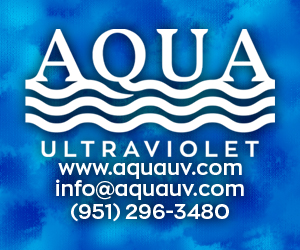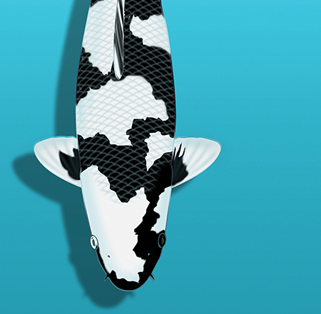So, you have a black and white koi and you’re not sure if it is a Shiro Bekko or Shiro Utsuri. There are many similarities between the two varieties…as well as distinct differences. Some characteristics are easy to recognize. The subtle differences will become familiar with practice. Both varieties have only two colors: black and white. Both varieties have non-metallic skin. Both are commonly seen as Wagoi, but are also produced with either Doitsu or Gin Rin scales.
In this article I’ll explain five easy ways to tell the difference between these two popular varieties of koi. Use the illustrations as a visual guide to help distinguish one from the other.
Color B&W or W&B? There are just two colors on Shiro Bekko and Shiro Utsuri koi: black and white. The Shiro Bekko is a white koi with black markings. The Shiro Utsuri is a black koi with white markings. Although, some Shiro Utsuri are predominantly white. The white base color is called Shiroji, whereas, black is known as Sumi. If either fish has a patch of Hi, however small, it would be classified as a different variety.
Spots vs. Bands: The Shiro Bekko will have isolated Sumi markings on its body. These spots will be distinct and separate from each other and placed evenly over the body. The Shiro Utsuri variety has wide bands of Sumi instead of individual spots. The solid black bands appear as significant patches of color. These patches may join together to form a checkerboard pattern. The size of the Sumi markings will help to determine which type of koi you have. The Bekko has spots and the Utsuri has bands of Sumi.
Top vs. Wrap: The Sumi location is another defining feature of each variety. On Shiro Bekko the Sumi spots are placed only on the top. They are visible on the koi’s back and only above the lateral line, whereas on Shiro Utsuri, thick bands of Sumi wrap around the fish often down to the belly and extend below the lateral line.
Clean face or patterned face? Evaluating the face will help you identify the variety. A Shiro Bekko usually has no Sumi on the head or face. It should have a blemish-free face that is the same as the base color (Shiroji) on the body. Just the opposite for Shiro Utsuri. On the Utsuri head you will find interesting black patterns, often dividing the face in half. Menware is a traditional Utsuri head-pattern. If a heavy black pattern starts on the face and continues the length of the koi, then you are looking at an Utsuri.Check out those pecs! Finally, look at the pectoral fins to differentiate between the two varieties. A Shiro Bekko generally has bright white pectoral fins, although an occasional black stripe may occur. With the Shiro Utsuri you should see black pigment in the pectoral joint; this feature is called Motogoro. Not every koi will exhibit this trait; some may have heavily striped pectoral fins, as well as Sumi stripes in the dorsal and caudal fins.
Non-traditional Scales
Both varieties are produced with non-traditional scale variations. Occasionally you may see a Bekko or Utsuri with Doitsu scales. This name, or description, is added as a prefix when scales are present only on the spine, along the lateral lines, or in both locations; Doitsu Shiro Bekko. The Doitsu scales are usually bigger than common koi scales. Likewise, the term Gin Rin precedes the variety name when the fish has shiny, light reflecting scales: Gin Rin Shiro Utsuri. Usually Gin Rin scales cover the koi’s body completely.
All the Colors of the Rainbow
The Bekko and Utsuri varieties are also produced in other colors. You may occasionally find the red and black coloring, as well as the yellow and black type. A red/orange-based Bekko is called Aka Bekko. A yellow-based Bekko is the Ki Bekko. Similarly, the red/orange-based Utsuri is called Hi Utsuri, and those with a yellow base are Ki Utsuri.
These types are quite rare; even more uncommon is the addition of Doitsu or Gin Rin scales.
Regardless of the base color, you can identify the Bekko or Utsuri using the guidelines listed above. Be sure to check out illustrations of many koi varieties on our website.
>> Follow this link to view them all: www.kloubeckoi.com/ellens-koi-education/





I found this to be super helpful. I shared it to my facebook page. Nature Perfect Pond and Supply. Thank you.